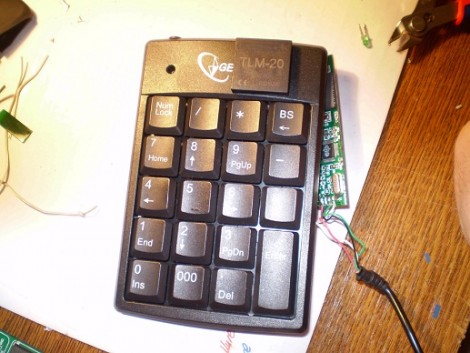
It turns out that hacking together a security keypad is remarkably simple if you know what you’re doing. [Don] needed to add a keypad with an RFID reader on it. He had previously built a USB RFID reader and thought he could integrate those concepts into the new unit.
He once again started with a serial to USB converter and removed the voltage converter IC for later use since he doesn’t need TTL levels for this project. The keypad is a USB product and it turns out there’s a hub inside. With plenty of space inside for the serial converter PCB and a blank spot at the top where he mounted the RFID reader, he adding a few passive components to wire it up and connect it to the hub. The only connection is the original USB cord but the PC will detect both the keypad and the converter.















Nice work.
wicked awesome.
why is it 12:55 here and 1:20 there where are you guys located anyway im in California
maybe the little keypad itself could be another level of security. could someone potentially install a knob-less door outside of a building, which would require you to hold the keypad up to an umarked “hotspot” on the wall next to it? while holding it up you could punch in the code and only that would disengage the lock. maybe it’d be cumbersome, but cool as all hell
@derwin I like the idea of that.
Minor correction to the summary: he can remove the level converter IC because he *does* need TTL levels instead of the ±12V usually specified by RS232. Most USB-serial chips have I/Os at TTL (5V) or 3.3V and you only need the level converter if you need to interface to other things expecting the higher RS232 levels.
@derwin, been watching Star Trek? :)
That idea is similar to a lot of sci-fi shows/films where someone ‘hacks’ a door open by attaching a device to the door opening mechanism and punches some buttons.
You’re right, it would be cool a hell to have an electonic ‘key’ entry system like that.
@derwin best idea I’ve heard in a while in these comments! A smaller compact keypad-card would be cool as shit! I’m envisioning hacking one of those smaller solar-calculator style keypads (possibly a hacked calculator keypad) that easily fits into your pocket.
I suppose if your going to goto all that trouble a LAN based control accessible by smart phone maybe easier to do. (has been done though) your idea I haven’t seen yet.
@derwin Also, after holding the keypad to the door and typing the code in, the door opens using a strange sideways lever arrangement with a mechanical pumping motion that bears no resemblance to the mechanical motion of the door!
of course. it would also let out a disproportionate amount of steam as it slowly creaks open.
hmm, smells like a typo: since he doesn’t need TTL levels … -> what he needs IS TTL-Level (5V, 3v3…) and NOT the UART Voltages (+-10V).
Nice hack anyway!
If you used the same type of inductive powering system that the RFID reader uses, you could eliminate a need for batteries in the keypad. I supposed that would make it easier to find the “G spot” with an RF sensor too, though.
I guess a super (funny) secure way of doing it could be 9 single rfid chips (or i guess one reprogrammable) connected to each of the buttons on the keypad. When a key is pushed the rfid chip is connected to a central antenna on the board thus allowing to be read.
If the sequence is correct and read by the reader in a specific order, then the user is permitted entry.
@Eirinn
imagine coming home drunk..
:D